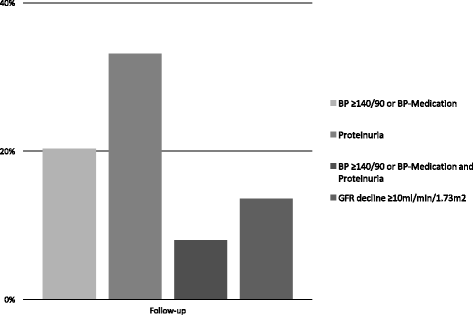Short term sequelae of preeclampsia: a single center cohort study
- PMID: 29783931
- PMCID: PMC5963132
- DOI: 10.1186/s12884-018-1796-z
Short term sequelae of preeclampsia: a single center cohort study
Abstract
Background: Data on the prevalence of persistent symptoms in the first year after preeclampsia are limited. Furthermore, possible risk factors for these sequelae are poorly defined. We investigated kidney function, blood pressure, proteinuria and urine sediment in women with preeclampsia 6 months after delivery with secondary analysis for possible associated clinical characteristics.
Methods: From January 2007 to July 2014 all women with preeclampsia and 6-months follow up at the University Hospital Basel were analyzed. Preeclampsia was defined as new onset of hypertension (≥140/90 mmHg) and either proteinuria or signs of end-organ dysfunction. Hypertension was defined as a blood pressure ≥ 140/90 mmHg or the use of antihypertensive medication. Proteinuria was defined as a protein-to-creatinine ratio in a spot urine > 11 mg/mmol. Urine sediment was evaluated by a nephrologist. Secondary analyses were performed to investigate for possible parameters associated with persistent symptoms after preeclampsia.
Results: Two hundred two women were included into the analysis. At a mean time of follow up of 172 days (+/- 39.6) after delivery, mean blood pressure was 124/76 mmHg (+/- 14/11, range 116-182/63-110) and the mean serum-creatinine was 61.8 μmol/l (33-105 μmol/l) (normal < 110 μmol/l). Mean estimated glomerular filtration rate using CKD-EPI was 110.7 mml/min/1.73m2 (range 59.7-142.4 mml/min/1.73m2) (normal > 60 mml/min/1.73m2). 20.3% (41/202) had a blood pressure of 140/90 mmHg or higher (mean 143/89 mmHg) or were receiving antihypertensive medication (5.5%, 11/202). Proteinuria was present in 33.1% (66/199) (mean 27.5 mg/mmol). Proteinuria and hypertension was present in 8% (16/199). No active urine sediment (e.g. signs of glomerulonephritis) was observed. Age and gestational diabetes were associated with persistent proteinuria and severe preeclampsia with eGFR decline of ≥ 10 ml/min/1.73m2.
Conclusion: Hypertension and proteinuria are common after 6 months underlining the importance of close follow up to identify those women who need further care.
Keywords: Follow-up; Preeclampsia; Sequelae.
Conflict of interest statement
Ethics approval and consent to participate
This study was approved by the Swiss Ethic Committee of northwest and central Switzerland as part of the swissethics association to be conducted under Art. 34 HFG, ART. 37-40 HFV of Swiss Federal Law waiving the need for consent.
Competing interests
The authors declare that they have no competing interests.
Publisher’s Note
Springer Nature remains neutral with regard to jurisdictional claims in published maps and institutional affiliations.
Figures
References
MeSH terms
Substances
LinkOut - more resources
Full Text Sources
Other Literature Sources
Medical
Research Materials
Miscellaneous



